EAA Chapter 1410 High River Hosts the B-17
By Jack Dueck, Chair, EAA Canadian Council
July 2016 - “Beyond our wildest dreams” was EAAer Jeff Seaborn’s comment on the successful visit of the EAA’s B-17 to Calgary. The week ending on Sunday, June 26, saw an incredibly enthusiastic crowd enjoy the sights and sounds of the four round engines of the B-17 Flying Fortress, Aluminum Overcast, at Springbank Airport, Calgary, Alberta.
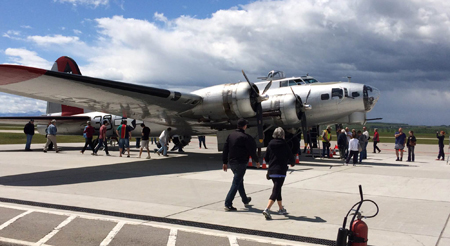
By Monday morning some 247 individuals had the privilege of enjoying the flight that thousands of young men experienced in combat during World War II. In addition, thousands of folks enjoyed the ground tour seeing the inside of this bomber. We were originally given the opportunity to fly up to 16 flights, four per day. In the end, we had 25 full flights. The crew added flights Friday, Saturday, Sunday, and even added one on Monday morning to get them all in. We had more interest than that, but the pilots and crew were exhausted and we had to turn people away. It was estimated that another six flights could easily have been sold out.
Ground tours were well-attended. On Thursday and Friday we had a couple hundred people go through per day with a 10- to15-minute wait time. On Saturday, with variable weather, we got closer to 300 people through and wait times went up to about an hour. On Sunday the weather broke, and it was warm and sunny. We had well over 400 people go through, and at one point we had wait times approaching two hours. On both Saturday and Sunday we stopped selling ground-tour tickets between 2:30 and 3 p.m.to allow everyone who bought a ticket to get through the plane. Despite the long waits, people were very keen and positive. We allowed anyone and everyone to wander around the ramp to look at the plane. We’d also parked a couple of other interesting aircraft nearby for the public to look at. Additionally, we had a partially built RV-6 and some information boards there to show what EAA’s original mission was and how it has expanded to include all areas of aviation.
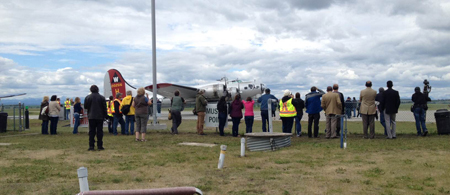
Up to 50 gathered at the fence to watch the startup
So what made this project so successful?
Planning for this venture started a year ago when John Mader and I were invited to see the bomber at various sites in the United States. John enjoyed the activity in Spokane, Washington, and I went to Hayward, California. Plans to include several Western Canadian cities began in earnest early in 2016.
It became apparent early on that the success of this venture depended on a great deal of planning, particularly the presale of seats well before the appointed arrival time. Our EAA Chapter 1410 voted in favor of hosting this venture in March. John Mader took on the responsibility and set up the various tasks.
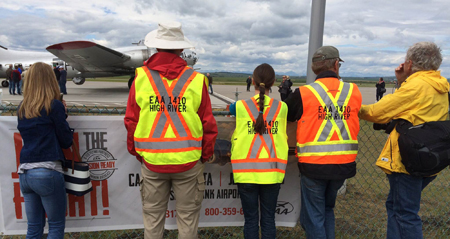
EAA Chapter 1410 members managing activities
John developed a Memorandum of Agreement (MOA) for the Calgary Airport Authority and presented it to Larry Stock, manager of the Springbank Airport. At the same time Jeff Seaborn assumed the responsibility of advertizing and media accommodation. Almost immediately the problem of timing arose; Larry was hesitant to have too much advertizing out there until the legal departments of the Calgary Airport Authority and EAA headquarters agreed on the final draft of the MOA, while a real push was put on to maximize information output. All in all, Larry Stock and the Airport Authority were supportive and helpful in every way.
John Mader worked every detail that he could imagine might impact this project. One of the early concerns was where to put the command center. He approached Nav Canada, which had the building facing the runway, and he received permission to use it as our operational base. Kudos to Nav Canada for this very important contribution.
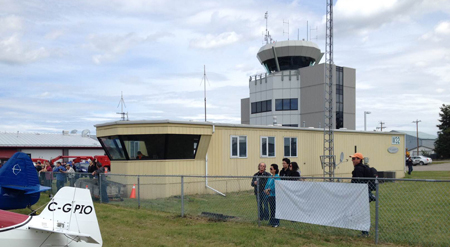
Nav Canada building as command center
A real stroke of luck occurred when Doug Curtis, a 94-year-old veteran who had flown 48 missions as a tail gunner in a Lancaster during the war, fulfilled a wish on his bucket list by skydiving out of an aircraft at Beiseker, Alberta. The media ate this up, and Jeff managed to leverage this event by including Doug in one of our two media flights over Calgary. Jeff was able to get the CBC, CTV, and Global networks all to carry the story. Additional newspaper groups also included the visit of the B-17.
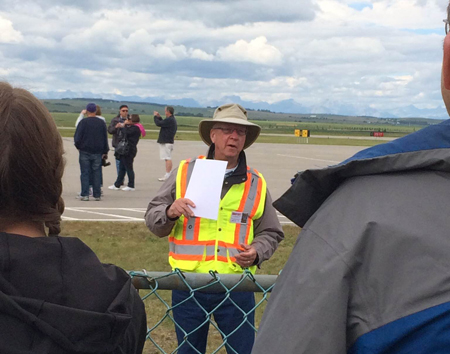
Rene addressing the crowd
Rene Provost contacted every association that might be interested or connected, including various legions, the Nanton Bomber Command, and senior housing groups. Rene distributed flyers to countless venues, virtually every vertical board he could find! During the B-17 visit Rene continually entertained the crowd with stories about the U.S. and Allied forces during the war.
During the final days before this event, a snag developed in that Transport Canada had not approved the B-17 maintenance program. Apparently the many e-mails and telephone calls to the Ottawa headquarters remained unanswered, and without this approval EAA was unwilling to proceed in Canada. A phone call to our local Transport Canada Airworthiness Authority helped to resolve this issue in time for the venture to proceed. Dave Sward of Transport Canada deserves a big shoutout for helping us get through this hurdle.
So from Friday through Sunday (with one additional flight scheduled for Monday morning) we had standing room only. Weather, although a concern, proved to cooperate, and no flights had to be cancelled. By Saturday evening all available flights had been booked, and the cancellation list was also filled and had to be stopped. Many prospective rides were turned away, and many of those folks who wanted to tour the aircraft were denied simply because of time available. Many expressed a hope that the B-17 would return again next year.
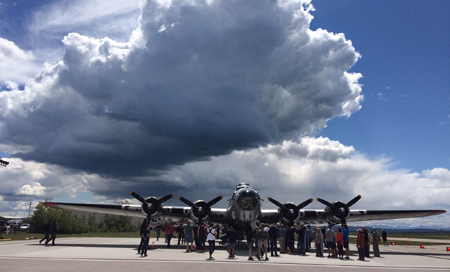
At U.S. sites, the B-17 crew travels with two support trailers that also carry merchandise that can be purchased. Because of border-crossing issues, the crew elected not to include this feature on this tour. Many folks were disappointed. In addition, we experienced problems with credit card authorization since the fees were not converted to Canadian dollars. Some folks were charged Canadian prices in U.S. dollars; a problem that was corrected but that nevertheless posed an issue. These issues should be resolved before the future tours take place.
From Springbank, Aluminum Overcast flew to Regina for a repeat performance and then to Manitoba where it operated out of Gimli. We all agree we want to repeat this visit to Canada, and with the lessons learned, it can only be a positive result for both the B-17 personnel as well as the thousands of individuals who enjoyed this year’s performance at Springbank Airport. The overwhelming support of our Calgary citizens proves the point.
What made it a success?
Promotion
We started promoting it months ago. We printed off the posters before we got our promotion package from EAA. We blanketed the city with these posters, specifically targeting locations we expected veterans and their families would see. Legions, senior homes, museums, etc. We put up posters at just about every small airfield in southern Alberta. We contacted the media and tried arranging coverage for the media flight. Jeff Seaborn was personally in charge of this and found it challenging. The media doesn’t respond to requests or e-mails. He found that they don’t commit to anything, as they will chase the hottest story for the day. As luck would have it, the media did show up, and they had a memorable experience.
Flight route
The tour stop for Calgary was out of Springbank Airport on the west side of Calgary. Our tour organizer arranged the flight route for maximum exposure to the city. It had to be clear of the flight paths for Calgary International, but the flight was over a large portion of the city. This created repetitive reminders to the public about the flights. Jeff had many people mention to him that they’d heard about the event but had forgotten until they’d heard the B-17 fly over. The flights were a constant reminder to the public. Besides, those on the flight love to look down to see if they can locate their neighbourhood or even their own house.
Volunteers
We had lot of volunteers and they had to be visible. One of our chapter members donated 20 high-visibility safety vests, which he had embroidered with “EAA Chapter 1410” on the back. They were wonderful additions as they made it very easy for the public to identify the people in charge or to answer their questions. During flight times, we needed to keep people off the ramp during startups and shutdowns. People are keen to capture that “magic” photo, so they tend to forget that they are on a working ramp. We needed to be diligent about keeping them safe. Additionally, the volunteers on the ramp were invaluable for the ground tours, and we needed many of them during that time. The volunteers kept people informed and entertained with information and stories. Even if our volunteers didn’t know anything about the B-17 to start with, they quickly learned some interesting facts and were happy to share what they had learned. We also needed to ensure that the car parking didn’t cause any issues for the businesses and other flyers at Springbank. Having a large crew of volunteers working the parking lots allowed us to maximize our parking space and minimize congestion. Again, the high visibility vests were invaluable there. The drivers could easily identify who was directing them to parking, and they respected the vests. We had to keep our volunteers fresh and rotate them through for rests and keep them hydrated with bottles of water.
Logistics
Our tour organizer spent hours agonizing over the details, and it was worth it. For example, he arranged to have the local café, which is normally closed on Sunday, to be open for the day. I think the café appreciated it as much as the public did. The proprietor arranged to have half a dozen port-a-potties on site, and he arranged garbage cans for easy access by the pilots and crew.
During the ground tours, the pilots and crew left for lunch and a well-deserved break. At that point the plane was 100 percent our responsibility. Afterwards the crew came back and met with the public for the later flights. Our tour organizer arranged for a separate building for the ground crew to register the people for their flights. It was also the central hub for the volunteers. He also ensured that we had sufficient signage at Springbank, so the public knew where to go, where to park, and where not to park. No detail was too small.
The crew in the B-17 is very experienced in these tours, and they are great ambassadors for EAA and aviation. The ground crew and mechanics whom we worked with finished their three-week tour with us and have been replaced by a fresh group. We didn’t have a lot of time to get to know the new group, but they seem to be just as friendly and professional as the group we worked with.
Lorraine and Ken are the pilots, and they are wonderful people. They take turns in piloting the B-17 and are continuing on for the complete tour in Canada. Lorraine is great with the public, and the media love her. She is very passionate about the plane and the experience. She is a very capable pilot but, as she acknowledges, Ken is a little bit better. You’ve got to see him fly an overhead break and a fighter-type curving approach into landing. Wow. He finishes the descending turn, levels out, and flares over the numbers perfectly, every time.
It was an honour to host this plane and crew and to see the interest it draws. It was important to talk to the public and hear their stories. A lot of the public don’t know the difference between a propeller and a pitot tube. This is a wonderful opportunity to promote aviation and share the passion. There are also many people who are pilots or historians who are well-versed on many of the aspects of the plane or the war, and they are wonderful to speak with as well. Lastly, there are many people who either fought in the war or have relatives who fought in the war. They all have amazing stories to share. We wish we could have heard them all.
Last minute news from Regina:
We had a busy, long weekend in Regina with the B-17. The event started with a flyby of the tower at 15 Wing Moose Jaw (home of the Snowbirds) on the repositioning flight from Calgary. Moose Jaw media was alerted, and the B-17 did a pass over Moose Jaw as well for a bit of early publicity.
We were well supported by the local media in Regina and had enough interest for two media flights on Wednesday. An empty seat on the media flight offered us the opportunity to fly one of the Regina tower crew to give him a better feel for what was going on. Overall we were very welcome at CYQR and had lots of visitors from the fire crews, security, and other airport authority personal eager to see the B-17.
The numbers:
Twenty-one flights, 208 seats sold.
With more than 1,500 people on ground tours, we used three rolls of stickers (500 per roll) and were into the emergency backup supply. The ground tour sales number is lower when you take into account family sales and veteran/military stickers given out.
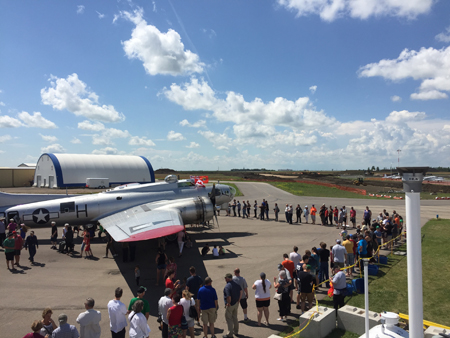
Regina enthusiasts line up for the ground tour
Volunteers:
Schedule called for three security, three ground tour, and two sales people on two-hour shifts. Malcolm and I were also on site at most times to manage volunteers, crew requests, and assist.
Sales shift started at 11 a.m. and helped manage people arriving prior to ground tours at 1 p.m.
Volunteers tended to arrive early and stay late. The crowd was excellent and cooperative, even standing patiently behind our virtual security line of traffic cones while we switched over from flight ops to ground-tour mode.
Volunteer T-shirts identified our people to attendees. This worked well as the crowd knew who to ask questions of and would take direction from when requested to comply with security concerns. Ramp volunteers also used orange security vests.
Other items:
As in Calgary, we went through the ground-tour line with cups and a jug of water on the hot and sunny day.
Ground-tour sales were shut off early due to the long lines. The EAA tour coordinators assisted in making the call on shutoff times.
A handout with B-17 facts and local tie-ins was popular. We ran out of these each day.
Thanks to Mark for having the Cornell on display on Saturday. The EAA crew was excellent to work with! Best of luck with the Gimli tour stop.
